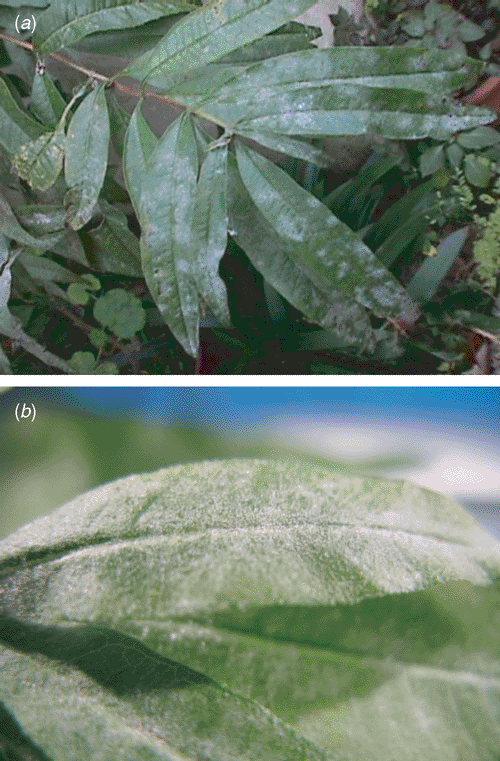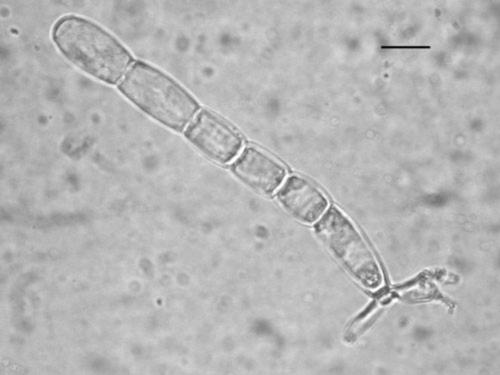First report of powdery mildew on Aloysia spp. (Verbenaceae)
S. M. Wolcan A C and Y. Sato BA Comisión de Investigaciones Científicas BA, CIDEFI, Facultad de Ciencias Agrarias y Forestales, UNLP, 60 y 119, La Plata, Buenos Aires 1900, Argentina.
B Faculty of Engineering, Toyama Prefectural University, Kurokawa, Imizu-shi, Toyama 939-0398, Japan.
C Corresponding author. Email: swolcan@speedy.com.ar
Australasian Plant Disease Notes 2(1) 113-114 https://doi.org/10.1071/DN07047
Submitted: 12 June 2007 Accepted: 15 July 2007 Published: 26 July 2007
Abstract
A powdery mildew caused by Oidium subgen. Striatoidium (Neoerysiphe sp.) on Aloysia citriodora in Argentina is described. This is the first report of powdery mildew on Aloysia spp.
Aloysia citriodora (lemon verbena, herb Louisa) is an aromatic shrub native to Argentina and Chile. It belongs to the family Verbenaceae and was also classified as A. triphylla, Lippia citriodora, Verbena citriodora and V. triphylla. The plants are characterised by fragrant, lemon-smelling, narrow leaves and small white flowers borne in terminal panicles. The leaves and flowering tops of lemon verbena are used in infusions, to flavour alcoholic beverages, and as an ingredient in some desserts, fruit salads and jams. The plant produces an essential oil that is used in perfumery, especially in making toilet water and eau de cologne. The leaves and flowers have been used medicinally because of their antispasmodic, antipyretic and sedative properties. Moreover, this plant is often cultivated as an ornamental, deciduous shrub. There are commercial crops in Mexico, Venezuela, Brazil, Bolivia, Peru, Uruguay, Chile and Argentina (Muñoz et al. 2001).
During the spring of 2002, typical white powdery patches of mycelium and conidia of powdery mildew were observed on leaves of lemon verbena plants (Fig. 1a) in gardens of La Plata city (34°55′S; 57°57′W). The disease was observed each year from the appearance of young leaves in spring to the fall of older ones at the end of autumn.

|
Characteristics of the fungus are: mycelium is amphigenous, primarily on the adaxial side of leaf surfaces, forming at first round colonies and then conspicuous patches that often coalesced and cover all the surfaces (Fig. 1b). They are generally white to greyish. Hyphal appressoria are lobed or multilobed, sometimes nipple shaped, opposite or not. Anamorph features include straight and short conidiophores with foot cells, nearly cylindrical and very small (24–39 × 9–12 µm) which are followed by 1–3 shorter cells. Conidia are produced in chains, ellipsoid-ovoid to doliiform, 27–30 × 15–18 µm (Fig. 2). No fibrosin bodies are observed. Germ tubes are apical or subapical, having lobed or multilobed appressoria on terminating and/or basal position. The cleistothecia of the fungus have not been observed to date. On the basis of the combination of the production of conidia in chains and the predominance of lobed appressoria on the mycelia and germ tubes, the fungus was identified as Oidium subgenus Striatoidium (anamorphic stage of Neoerysiphe sp.) (Braun 1999).

|
To verify the pathogenicity of this Oidium sp., plants of A. citriodora were inoculated. Detached leaves of lemon verbena with mildew colonies were gently pressed onto healthy leaves of six plants growing in pots. Four non-inoculated plants were used as a control. The inoculated plants as well as the symptomatic leaves were covered with plastic bags for 48 h and kept at 22–25°C. Non-inoculated plants were maintained in the same conditions in another compartment. Typical symptoms of powdery mildew began approximately from 8–10 days after inoculation. Control plants remained healthy.
The specimen was deposited in the Institutional Herbarium of Centro Regional Universitario Bariloche, San Carlos de Bariloche (BCRU), Argentina, under the specimen number of BCRU 04878, and in the Mie University Mycological Herbarium (MUMH), Japan, under the number of MUMH 3068.
This is the first report of Oidium subgenus Striatoidium on Aloysia citriodora and the first report of powdery mildew on Aloysia spp.
Acknowledgements
To Dr Susumu Takamatsu and Dr María Havrylenko for their valuable suggestions.
Braun U
(1999) Some critical notes on the classification and genetic concept of the Erysiphaceae. Schlechtendalia 3, 49–55.



